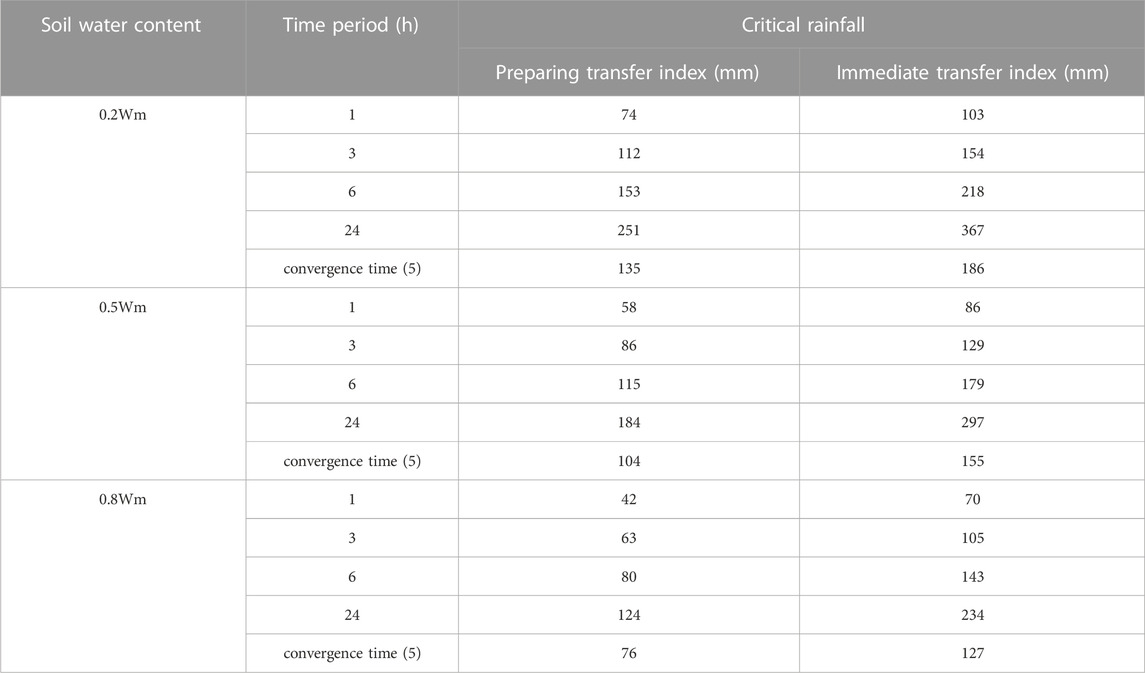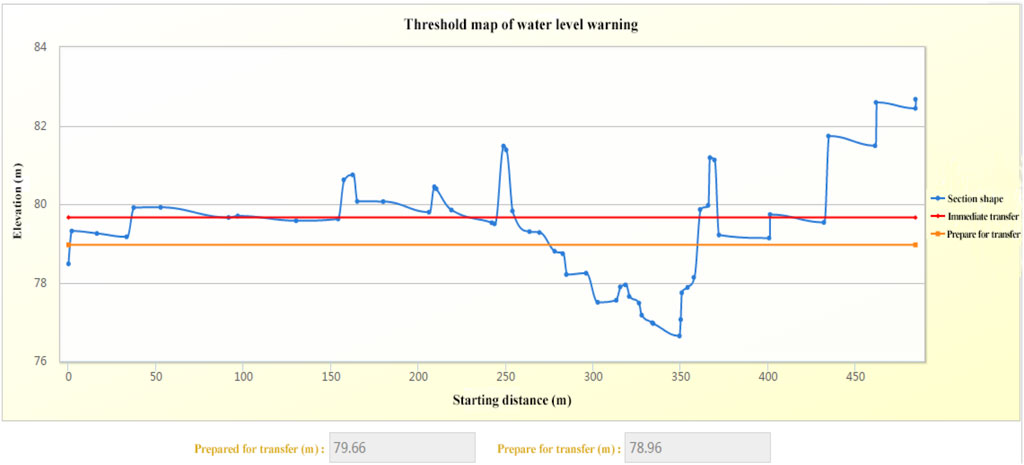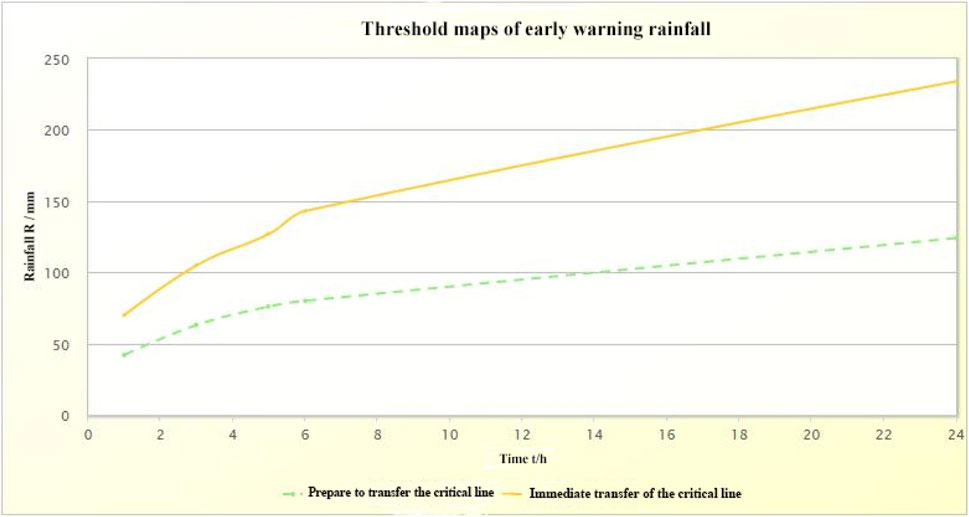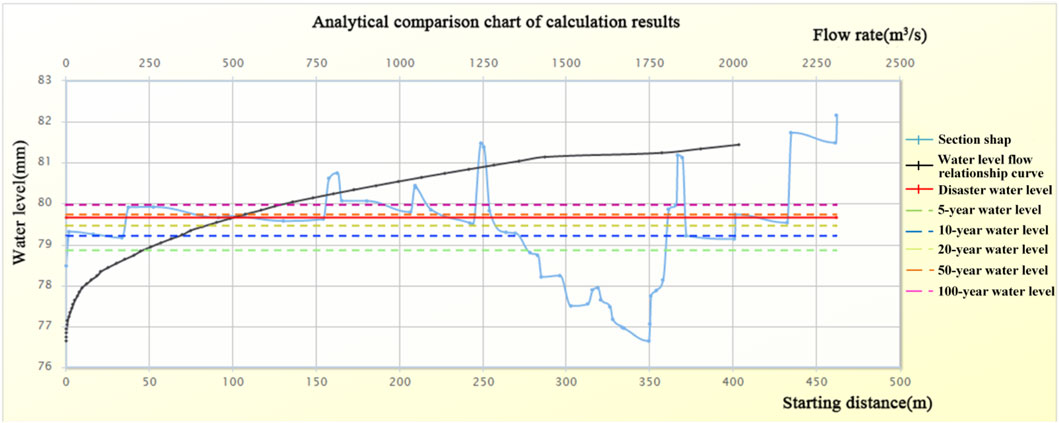- North China University of Water Resources and Electric Power, ZhengZhou, China
Mountain torrent disaster prevention is the focus of flood control and disaster reduction in China. Critical rainfall is an important indicator to determine the success or failure of mountain torrent disaster early warning. In this paper, the M-Copula function is introduced, the multi-dimensional joint distribution of critical rainfall is constructed, and the joint distribution of rainfall and peak rainfall intensity is analyzed. Taking A village in Xinxian County as an example. The critical rainfall of the combined probability is calculated, and the critical rainfall of the flash flood disaster water level, the pre-shift warning and the sharp-shift warning is warned and analyzed. The results show that the flood peak modulus calculated by Yishangfan group is 8.89, which has certain rules for the flood peak modulus of rivers in hilly areas. The larger the basin area is, the smaller the flood peak modulus is, the smaller the area is, and the larger the flood peak modulus is. The calculation result of the design flow of 533 m3/s is reasonable. It is reasonable and reliable to select the M-Copula function as the connection function to fit the joint distribution of rainfall and peak rainfall intensity, which can provide theoretical support for flash flood disaster warning in other regions.
Introduction
In recent years, due to the increasing impact of climate change and human activities, mountain flood disasters have become more and more frequent. Mountain flood disasters have become one of the main natural disasters in the world, causing a large number of casualties and social and economic losses (He et al., 2021; Ren Z. H. et al, 2023). In order to prevent mountain flood disasters and reduce disaster losses, timely and effective disaster warning is the key factor to determine the success or failure of mountain flood disaster prevention and control. Therefore, many experts and scholars have studied the early warning of mountain flood disasters. Europe has developed a flood warning system by coupling climate model and hydrological model, which can be combined with fine weather forecast to realize early flood warning (Park et al., 2019). Japan established the relationship between rainfall and surface runoff, and proposed a mountain flood warning method based on watershed rainfall index to achieve high-precision mountain flood warning (He, 2020). The underlying surface conditions and the mechanism of mountain flood disasters in China are complex, and the critical rainfall is the main influencing factor of mountain flood disasters. At present, the calculation methods of critical rainfall mainly include data-driven method and hydrological hydraulics method (Wang, 2021; Shen and Hao, 2022; Zhao, 2022). Han, J. T. et al. (2022) constructed a mountain flood disaster warning method based on the dynamic critical rainfall method, and obtained the critical flow and critical rainfall corresponding to the risk level. Wang, W. L. et al. (2022b) introduced the pattern recognition algorithm into the calculation of critical rainfall, and proposed a calculation method of critical rainfall based on Fisher discriminant algorithm. Based on the HEC-HMS model, Zhang, S. S. et al. (2019) selected the rainfall warning index, and comprehensively considered the factors such as soil water content and confluence time to reverse the critical rainfall.
Copula function has become the main means of probabilistic risk research (Li, 2020). Domestic and foreign scholars research on Copula function mainly focuses on univariate and bivariate perspectives. For example, Yang, et al. (2018) used the Palmer dry early index and Copula function to evaluate the risk of dry early in Northwest China, and identified the frequency of extreme drought and extreme wetness; Hui-Mean, et al. (2019) introduced the joint distribution of multivariate Copula functions to study the correlation and dependence between drought risk variables in the Malaysian Peninsula; Menna, et al. (2022) constructed the joint probability distribution of SPI and SSI based on Copula function to study the dry and early risk analysis of the basin. In the above research, the spatial scale of the research is mainly concentrated in large areas, but there is a lack of research on the local regional scale, and the joint distribution function is rarely related to its respective edge distribution function.
In general, the research results of critical rainfall are fruitful, but the critical rainfall and corresponding early warning analysis of several risk combinations are not considered. The random variables in the field of hydrological science often show various complex linear and nonlinear correlations. Therefore, the Copula function is introduced to describe the correlation between rainfall and peak rainfall intensity variables in this paper. The Copula function can connect the joint distribution function with its respective marginal distribution function, and can describe the nonlinear, asymmetric and symmetric correlation between variables, and it is widely used in hydrological science (Chen, 2022; Wan, 2022; Wang, 2022; Zheng, 2022).
Study area
Xinxian County is located in the Dabie Mountains in the southeastern part of Henan Province. It is located on the ridge line of the Yangtze River and Huaihe River basins and on the boundary between the northern subtropical and the northern warm temperate zones. It is a transitional zone between the summer monsoon and the subtropical high moving north and south. Frequent rainstorms, complex geological landforms, and the impact of human activities have led to frequent flash flood disasters. Mountain torrent disasters are widely distributed in the county and are characterised by fierce, fast flowing, destructive and sudden, and are difficult to forecast, predict and prevent. It not only causes devastating damage to the infrastructure of the hilly area, but also poses a great threat to the life safety of the people, and has become a prominent problem in the current disaster prevention and mitigation work. It is one of the important constraints on the sustainable economic and social development of the hilly area.
Xinxian County is a subtropical continental monsoon climate, a north-south climate transition zone, four distinct seasons, water and heat at the same time, ravines, rivers, rivers in the county can be summarised as “two major watersheds, six major water systems”. Among them, the Huaihe River Basin has four water systems: Huanghe River, Bailu River, Zhugan River, and Zhaihe River; there are two water systems in the Yangtze River Basin: Daoshui River and Jushui River. The average drop of the main rivers is 320 m, and the river gradient is generally above 0.3%, and the maximum is 3.3%. Large slope, short flow, fast confluence and narrow riverbed form the characteristics of fierce water potential and large difference in water volume change in Xinxian River.
The disaster-causing factors of mountain torrent disaster in Xinxian County have the dual attributes of natural geography and economic society. The general trend of the terrain in Xinxian County is high in the middle and low in the north and south. The mountains in the territory are towering, the mountains are stacked, and the streams are crisscrossed. Rainfall factor is the direct factor and excitation condition of mountain flood disaster. Rainfall is large, and high-intensity rainfall is one of the most important causes of flash flood disasters. Under the same conditions, the longer the rainfall duration, the greater the rainfall, the greater the runoff generated, and the more serious the loss of flash flood disasters. The law of mountain torrent disasters in Xinxian County has the following characteristics: the occurrence time is relatively concentrated, generally in June to September; affected by factors such as uneven spatial and temporal distribution of rainfall, high mountains and steep slopes, the rainstorm produces fast runoff, short confluence time, fierce water potential and great destructiveness. Mountain torrent geological disasters are prone to a wide range, sudden and difficult to monitor.
Data were collected from Resource and Environment Science and Data Center (https://www.resdc.cn/Default.aspx) and the National Meteorological Science and Data Center (http://data.cma.cn/).
Determination of critical rainfall of risk combination probability of mixed Copula function
Copula function distribution model
The Copula function can be used to describe the correlation between variables, which can connect the function of the joint distribution with its respective marginal distribution function (Song, 2023).The relationship between the variables in the hydrological system is complex and changeable, not confined to a specific relationship (Li, 2021). The commonly used Copula function can only reflect a certain aspect of the correlation between hydrological variables, so it is difficult to use a simple Copula function to fully describe the correlation between hydrological variables. Therefore, this paper selects the mixed Copula (M-Copula) function to describe the correlation between variables in the hydrological system (Li, 2022).
The expression is:
where
Parameter estimation, test and evaluation of Copula model
In this paper, the maximum likelihood estimation is used to estimate the parameters. The density function of its joint distribution function is:
where
The fitness evaluation of Copula function is calculated by using the minimum criterion of root mean square error RSME, its definition is as formula (3):
where
Critical rainfall determination for risk portfolio probabilities
Suppose that random variables
There are many coupling situations between the total rainfall and the peak rainfall intensity in the critical rainfall. The above joint probability distribution model can be used to calculate their joint distribution probability. This paper mainly considers the exceedance probability and conditional probability, that is, when the total rainfall exceeds a certain value, the conditional probability of the occurrence of the rainfall pattern when the peak rainfall intensity exceeds a certain value, as shown in Eq. 5.
In the formula,
Therefore, the combination probability
In the early warning and forecast of mountain torrent disasters, the return period is usually used to describe the magnitude of rainstorm. For the exceeding probability, the calculation formula of return period is as follows.
Early warning analysis of mountain flood disaster based on critical rainfall in Xinxian County
Risk warning calculation of critical rainfall with combined probability
Considering the river valley shape, flood rise rate, early warning response time and site location of the disaster prevention object, the early warning indicators of ready transfer and immediate transfer are determined on the basis of critical rainfall. The early warning index is used to check and correct the rainstorm flood, so as to avoid the large difference between the disaster water level and the corresponding rainstorm flood frequency.
Under normal circumstances, since the critical rainfall is calculated from the flood corresponding to the water level, the critical rainfall is numerically considered to be the immediate transfer index. For the preparation transfer index, it is ' reduced ' according to the preparation transfer time and flood hydrograph on the basis of critical rainfall.
This paper takes a village in Xinxian County as an example. Under the condition of different soil moisture content, the critical rainfall of 1h, 3h, 6h and 24 h is calculated by using the risk probability rainfall pattern, and the critical rainfall warning threshold is shown in Table 1. Threshold map of water level warning is shown in Figure 1. Threshold maps for the preparation and immediate diversion of early warning rainfall is shown in Figure 2.
Rationality analysis of results
The flood peak modulus of rivers in hilly areas has certain rules. The larger the basin area, the smaller the flood peak modulus, the smaller the area, and the larger the flood peak modulus. Therefore, the rationality of the design flood peak flow can be indirectly evaluated according to the statistical data of the flood peak modulus of the hydrological section in the hilly area of Henan Province. According to previous empirical data (Fan and Bao, 2022; Ren Z. H. et al, 2023), the flood peak modulus corresponding to the design flood peak flow of the small and medium-sized river section once in 50 years is generally about 10.0, and the majority is below 10.0. It can be seen from Table 2; Figure 3, the flood peak modulus calculated by Yishangfan group is 8.89, so the design flow calculation results are considered to be basically reasonable.
Conclusion
The analysis of mountain flood warnings in the Xinxian County shows that the mixed Copula function can describe the correlation between variables in the hydrological system more flexibly. The Copula distribution function can well fit the correlation structure and distribution between the two-dimensional joint distribution function variables of total rainfall and peak rainfall intensity. According to the minimum criterion of root mean square error RSME, the M-Copula function is selected as the connection function to fit the joint distribution of critical rainfall. Based on the calculation and analysis of a village in Xinxian County, the critical rainfall of combined probability is calculated, and the critical rainfall of water level, preparation transfer warning and immediate transfer warning of mountain flood disaster is warned and analyzed. The results show that the flood peak modulus of rivers in hilly areas has certain rules. The larger the basin area is, the smaller the flood peak modulus is. The smaller the area is, the larger the flood peak modulus is. The calculation result of 533 m3/s is reasonable. Therefore, the early warning analysis of mountain torrent disaster should ensure the safety of the people to the maximum extent. In the analysis and evaluation, the flood duration of villages along the river is taken as the basis, the response time and distribution of rainstorm flood warning in villages along the river are analyzed, which plays an important role in the preparation and early warning of mountain torrent disaster prevention and control plan.
Data availability statement
The data analyzed in this study is subject to the following licenses/restrictions: The data is confidential. Requests to access these datasets should be directed to https://www.resdc.cn/NewsInfo.aspx?NewsID=9.
Author contributions
QC: Writing–original draft. FaW: Writing–review and editing. FZ: Writing–review and editing. FeW: Writing–review and editing. WH: Writing–review and editing. ZD: Writing–review and editing. SY: Writing–review and editing.
Funding
The author(s) declare financial support was received for the research, authorship, and/or publication of this article. The research was supported by the National Key Research and Development Program of China (2022YFC3202300), Open Fund of Key Laboratory of Flood and Drought Disaster Defense, the Ministry of Water Resources (KYFB202307260036), Open Research Fund of Science and Technology Innovation Platform of Engineering Technology Research Center of Dongting Lake Flood Control and Water Resources Protection of Hunan Province, Hunan Water Resources and Hydropower Survey, Design, Planning and Research Co., Ltd. (HHPDI-KFKT-202304), Major Science and Technology Special Projects in Henan Province (201300311400), General Science Foundation Program of Henan Province (222300420491).
Conflict of interest
The authors declare that the research was conducted in the absence of any commercial or financial relationships that could be construed as a potential conflict of interest.
Publisher’s note
All claims expressed in this article are solely those of the authors and do not necessarily represent those of their affiliated organizations, or those of the publisher, the editors and the reviewers. Any product that may be evaluated in this article, or claim that may be made by its manufacturer, is not guaranteed or endorsed by the publisher.
References
Chen, Q., Li, G. F., and Bao, J. (2022). Analysis of encounter probability of rainstorm in jingdezhen city and flood of changjiang river based on copula function. Water Resour. Power 40 (12), 125–128+151. doi:10.20040/j.cnki.1000-7709
Fan, H. L., and Bao, S. (2022). Study on key hydrological problems in early warning of Mountain Flood disaster. Haihe Water Resour. (02), 93–96+111.
Han, J. T., Wang, Z. R., and Yang, Y. T. (2022). Flash flood grading and warning based on dynamic rainfall thresholds. J. Hydroelectr. Eng. 41 (09), 67–76.
He, B. S. (2020). Overview of flash flood early warning methods of Japan Meteorological Agency. China Flood Drought Manag. 30 (Z1), 149–152. doi:10.15961/j.jsuese.202000981
He, B. S., Ma, M. H., Li, Q., Liu, L., and Wang, X. H. (2021). Current situation and characteristics of flash flood prevention in China. China Rural Water Hydropower (5), 133–138.
Hui-Mean, F., Yusof, F., Yusop, Z., and Suhaila, J., Trivariate copula in drought analysis: acase study in peninsular Malaysia. Theor. Appl. Climatol., 2019.138(1):657–671. doi:10.1007/s00704-019-02847-3
Li, H. S. (2021). Precipitation monitoring network optimization based on spatial information balancing model and integrated entropy-copula model. Nanjing, China: Nanjing University. doi:10.27235/d.cnki.gnjiu.2021.000356
Li, H. W. (2022). Assessment of meteorological drought risk in Xinjiang and its impact on agriculture and vegetation based on Copula method. Beijing, China: North China Electric Power University. doi:10.27140/d.cnki.ghbbu.2022.000090
Menna, B. Y., Mesfin, H. S., Gebrekidan, A. G., Siyum, Z. G., and Tegene, M. T. (2022). Meteorological drought analysis using copula theory for the case of upper Tekeze river basin, Northern Ethiopia. Theor. Appl. Climatol. 149, 621–638. doi:10.1007/s00704-022-04061-0
Park, S., Berenguer, M., and Sempere-Torres, D. (2019). Long-term analysis of gauge-adjusted radar rainfall accumulations at European scale. J. Hydrology 573, 768–777. doi:10.1016/j.jhydrol.2019.03.093
Ren, Z. H., Sang, Y. F., Yang, M. Y., Wang, Y., and Shang, L. (2023a). Progress of research on the methods for the early warning of mountain flash flood disasters. Prog. Geogr. 42 (01), 185–196. doi:10.18306/dlkxjz.2023.01.015
Ren, Z. H., Sang, Y. F., Yang, M. Y., Wang, Y. L., and Shang, L. (2023b). Progress of research on the methods for the early warning of mountain flash flood disasters. Prog. Geogr. 42 (01), 185–196. doi:10.18306/dlkxjz.2023.01.015
Shen, W. B., and Hao, P. (2022). Calculation of critical rainfall of flash flood in small watershed based on rainfall pattern analysis. Yellow River 44 (01), 52–57.
Song, Y. X., Suo, M. Q., and Liu, L. P., Application of Copula function in the analysis of joint drought characteristics in the upper reaches of Zhanghe River. Water Resour. Power, 2023,41(10): doi:10.20040/j.cnki.1000-7709.2023.2022
Wan, F., Xiao, L. F., Chai, Q. H., and Li, L. (2022). Study on the streamflow compensation characteristics of reservoirs in Luanhe River Basin based on Copula function. Water Supply 22 (2), 2311–2321. doi:10.2166/ws.2021.380
Wang, F. Y., Zhang, Y., Wang, S., Ying, Q. L., and Yu, F. L. (2022b). Using copula model to analyze consecutive wetting-drying occurrence in rainfall-runoff in hanjiang basin. J. Irrigation Drainage 41 (08), 95–105. doi:10.13522/j.cnki.ggps.2021546
Wang, W. L., Sang, G. Q., Cao, F. J., and Liu, C. J. (2022a). Critical rainfall indicator calculation for Mountain Flood disasters based on Fisher discrimination algorithm. J. China Hydrology 42 (02), 1–6. doi:10.19797/j.cnki.1000-0852.20200219
Wang, X. K., Yang, P., Sun, T., and Xu, Z. X. (2021). Study on division early warning of flash flood disaster caused by rainstorm in mountainous small watersheds. Adv. Eng. Sci. 53 (1), 29–38.
Yang, P., Xia, J., Zhang, Y., Zhan, C., and Qiao, Y. (2018). Comprehensive assessment of drought risk inthe arid region of Northwest China based on the global palmer drought severityindex gridded data. Sci. Total Environ. 627, 951–962. doi:10.1016/j.scitotenv.2018.01.234
Zhang, S. S., Wang, J. T., and Xu, Z. H. (2019). Mountain flood rainfall early warning based on HEC-HMS model in small watershed. China Rural Water Hydropower (7), 40–44.
Zhao, L., Sang, G. Q., Wu, W., Liu, C. J., and Wang, J. N. (2022). Critical rainfall prediction model for Mountain Torrent disaster based on random forest regression algorithm. J. Univ. Jinan 36 (04), 404–411+423. doi:10.13349/j.cnki.jdxbn.20220325.001
Keywords: mountain flood disaster warning, critical rainfall, mixed Copula function, joint distribution, Xinxian county
Citation: Chai Q, Wan F, Zhang F, Wu F, Han W, Ding Z and Yang S (2023) Early warning analysis of mountain flood disaster based on Copula function risk combination. Front. Environ. Sci. 11:1324690. doi: 10.3389/fenvs.2023.1324690
Received: 20 October 2023; Accepted: 22 November 2023;
Published: 07 December 2023.
Edited by:
Jing Liu, University of Birmingham, United KingdomCopyright © 2023 Chai, Wan, Zhang, Wu, Han, Ding and Yang. This is an open-access article distributed under the terms of the Creative Commons Attribution License (CC BY). The use, distribution or reproduction in other forums is permitted, provided the original author(s) and the copyright owner(s) are credited and that the original publication in this journal is cited, in accordance with accepted academic practice. No use, distribution or reproduction is permitted which does not comply with these terms.
*Correspondence: Fang Wan, d2FueGYxMDIzQDE2My5jb20=
 Qihui Chai
Qihui Chai Fang Wan
Fang Wan Wenhao Han
Wenhao Han



